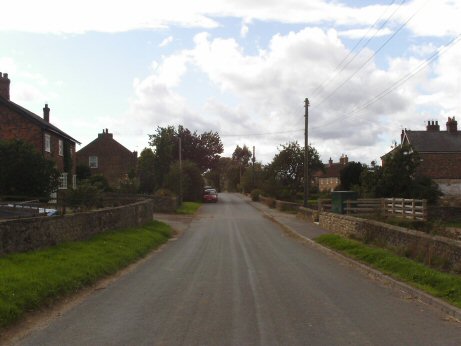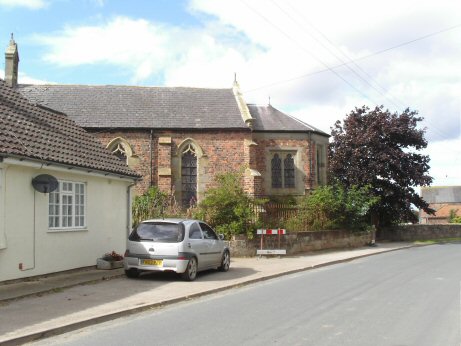
Photo: Chris Noble
Norton-le-Clay
Yorkshire

Photo: Chris Noble
Norton-le-Clay is a tiny village roughly to the east of Ripon. Just to the east of Ripon itself is the A1(M) road and a little more in the same direction is Norton-le-Clay. Further along the road running through the village is the neighbouring village of Cundall - another Thankful Village.

Photo: Chris Noble
Norton-le-Clay has a church dedicated to St. John the Evangelist but now redundant and being converted to a dwelling house. As far as we have been able to ascertain, there are no memorials relating to the Great War inside the building.
Chris Noble visited Norton-le-Clay for us and took some photographs, and he did find a Great War-related memorial elsewhere in the village - on the wall of a small house, "Ripon Cottage".
| This memorial takes the form of a stone plaque which names the sixteen
men of the village who served in the war and returned.
It also mentions Madame Maria Philomena Stes Roell, a Belgian refugee, who lived "in this house". Mme. Roell must have made quite an impression on the village to be named as "a noble woman" on the village war memorial, which was placed on the wall of the house in which she lived. On our behalf, Mary Moseley, Secretary of the Ripon and District Historical Society, checked the local parish registers and found that there is a record of a funeral at nearby Cundall:-
21 September 1915 Maria Philomena Stes ROELL Norton-le-Clay
The little church at Norton-le-Clay has no burial ground, so this must be why the interment took place at Cundall. Mary Moseley visited the church at Cundall but could find no inscription mentioning Mme. Roell on any of the legible gravestones. Mme. Roell's Death Certificate tells us that she died on eighteenth of September 1915 at Norton-le-Clay, of Cerebral Meningitis. The certificate also tells us that she was the wife of Alois Roell, Upholsterer, Belgian Refugee, Norton-le-Clay. Before the Great War, Alois and Maria Roell lived in the lovely Flemish town of Lier (then known as Lierre), about ten miles southeast of Antwerp, where they were both born in 1869. They had a shop and a house at Belarij No. 50. where they lived with their three children: Beatrice age 8 (on August 4th, 1914), Augusta age 7 and Jozef age 5. |
|
The German Army invaded Belgium on the 4th of August 1914. They were halted for a time at the crossing of the Meuse at Liege by the gallant defence by the Belgian Army of the Liege Forts, which finally ended on the 16th August. As the German Army advanced again, about 65,000 men of the Belgian Army retreated into the stronghold of Antwerp, which was protected by two lines of forts. One fort of the outer line was at Lier. The German Army built up the besieging force to two army corps, and at the beginning of October began a systematic reduction of Antwerp's defences. The outer line of forts was breached on October 3rd. The British Royal Naval Division arrived on the 4th. On the 5th the Germans penetrated the inner line of forts. The bulk of the Belgian Army escaped down the coast to Diksmuide (then known as Dixmude), and Antwerp surrendered on the 10th of October.
In the fighting, the Roells' shop and house were shelled and burned, like all the centre of Lier. "They had nothing left" (Hilde). Fleeing from the invaders, Alois and Maria with their children went by boat to Hull and from there to Norton-le-Clay. Mr. & Mrs. Turner took care of them at "Ripon Cottage". As Hilde, granddaughter of Alois and Maria, expressed it, "everyone was very kind for my poor family". Then tragedy struck again with the death of Mme. Roell from Cerebral Meningitis the following September. After the death of their mother, the two girls were sent to the Convent of Mercy at Boston Spa, and the boy went to a boarding school, unknown, (age 6 with a label round his neck and five changes of train - in Hilde's words, "poor guy").
The family returned to Lier sometime after the end of the war. Alois could not restart his shop, and worked for other people. He lived in a small apartment in Dijske No. 2, Lier. He died in Lier on the 27th of April 1954. The families Turner and Roell have kept up contact to the present time.
Our thanks to the Canon Nick Horton, Vicar of Norton-le-Clay and Cundall, to Pat Turner and to Hilde van Ouytsel, for their help and willing cooperation in uncovering the story behind the name on the Norton-le-Clay war memorial.
Danny Delcambre's website dedicated to the memory of Belgian war memorials
and to all Belgians, civilians as well as military, who died during the
wars
also has an
article
in memory of Mme. Roell.
Return to the "Thankful Villages" article